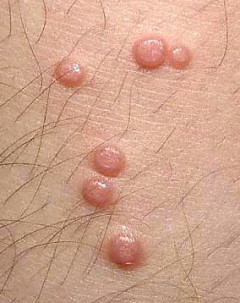Molluscum Contagiosum thrives as weather become warmer, more humid.
After having a bit too much Valentine’s Day candy, my friend’s 4-year-old daughter got her first canker sore. The bump was alarming to the little girl and she came running to my friend, mistakenly proclaiming, “Mama! I have a molluscum on my tongue!”
Molluscum is not a word you would expect to hear from a 4-year-old. However, molluscum contagiosum is a fairly common childhood rash and clearly, my friend’s daughter was so familiar with it, she assumed that was what the canker sore in her mouth was.
 What it is and what it looks like
What it is and what it looks like
Molluscum, which is caused by a virus, presents as small red or flesh-colored bumps. Often they will have a central dimple that may have a waxy white appearance.
In most cases, molluscum is not bothersome. That said, it can cause itchiness in some children. It can appear anywhere on the body including the face, neck, arms, legs, abdomen and genital area.
Most children have between a few to 10-20 lesions, but those who are immunocompromised can have upwards of 100. Children with eczema can also experience more severe lesions.
Causes
Children usually obtain molluscum via skin-to-skin contact or by touching something that carries the virus on it (towels, wrestling mats and more). It is very common for molluscum to spread amongst siblings, but parents should not be concerned about this, as it is difficult to contain. In the case of my friend, all three of her children have had molluscum at one point or another, which is why her 4-year-old knew the virus’s name.
Children can also spread the rash to different parts of their body by scratching an affected area and then touching another, unaffected one. While molluscum can be spread through direct contact, it is not necessary to keep your child out of school or daycare. It is appropriate, if the rash is present on the hands or other areas prone to touching, that it be covered.
Molluscum are often seen more frequently in the summer because the virus thrives in warmer/humid conditions.
Resolution of the virus
Most lesions will resolve spontaneously over a period of about six months without scarring. Treatment can help prevent spread to others and spread to other parts of the body, and is recommended especially in someone who is immunocompromised because the lesions fail to go away on their own.
Options for removal include:
- cryotherapy (freezing the lesions)
- curettage (scraping the lesions)
- topical therapies
These can all be done at a dermatologist’s office, but sometimes anesthetic is used because the procedures may be painful, particularly for younger kids. If the lesions are large or if many are present, the procedure may have to be repeated several times, every 3 weeks or so, until complete resolution.
Talk with your pediatrician if you notice symptoms consistent with molluscum. Together you can make the best decision for your child.
Maya Neeley, M.D., is a board-certified pediatrician specializing in hospital medicine at Monroe Carell Jr. Children’s Hospital at Vanderbilt. She adores her husband and four young boys and loves spending time with family and good friends. As a child, she always dreamed of becoming a children’s book illustrator but for now she just dreams of getting a good night’s sleep.

Vanderbilt’s Children’s After-Hours Clinics offer the convenience of a walk-in clinic with care provided by a board-certified pediatrician from Children’s Hospital. Find a location near you.

